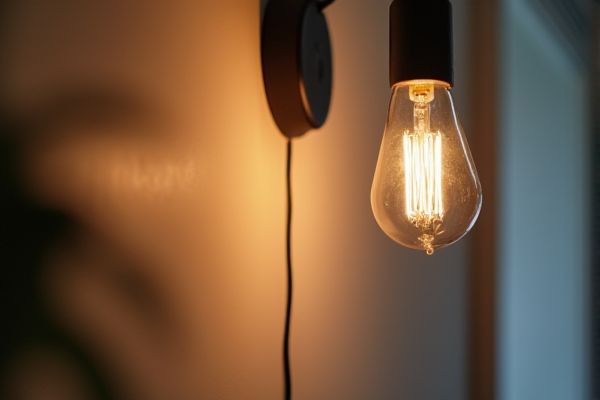
Sconces provide ambient or accent lighting by mounting on walls, ideal for highlighting specific areas or creating cozy atmospheres without occupying ceiling space. Your choice between a sconce and a pendant light depends on your room's layout and lighting needs; discover more lighting tips and comparisons by reading the full article.
Table of Comparison
| Feature | Sconce | Pendant Light |
|---|---|---|
| Mounting | Wall-mounted | Ceiling-mounted |
| Space Usage | Saves floor and table space | Requires ceiling clearance |
| Light Direction | Primarily accent and ambient lighting | Focused or ambient lighting, often adjustable height |
| Installation | Typically easier, less wiring | Requires ceiling electrical box |
| Design | Subtle, blends with wall decor | Statement piece, decorative focal point |
| Common Usage | Hallways, bathrooms, accent walls | Kitchens, dining rooms, entryways |
| Cost | Generally lower | Varies, often higher due to design |
| Adjustability | Fixed position | Often height adjustable |
Introduction to Sconce and Pendant Lights
Sconce and pendant lights serve distinct functions in interior lighting design, with sconces typically mounted on walls to provide ambient or accent lighting while saving floor space. Pendant lights hang from ceilings, offering direct illumination and often acting as focal points in rooms such as kitchens or dining areas. Your choice between these fixtures depends on the desired lighting effect, room layout, and aesthetic preference.
Key Differences Between Sconces and Pendant Lights
Sconces are wall-mounted light fixtures that provide focused or ambient lighting, commonly used for accent or task lighting along hallways and walls. Pendant lights hang from the ceiling by a rod or chain, offering direct illumination ideal for dining areas, kitchens, or entryways. The primary differences lie in their mounting position, lighting scope, and functional applications, with sconces enhancing wall space and pendant lights serving as central or decorative overhead lighting.
Design Styles and Aesthetic Appeal
Sconces offer a versatile range of design styles, from traditional to modern, providing subtle ambient lighting that enhances wall space with decorative appeal. Pendant lights create a bold focal point, available in various shapes and materials, ideal for adding visual interest and defining areas like dining tables or kitchen islands. Your choice between sconces and pendant lights depends on whether you prefer understated elegance or a striking statement piece to complement your interior aesthetic.
Placement and Application in Interior Spaces
Sconces are ideal for wall placement, providing ambient or accent lighting in hallways, living rooms, and bedrooms without occupying floor or table space. Pendant lights hang from the ceiling, offering focused illumination over dining tables, kitchen islands, or entryways, making them perfect for task lighting and statement pieces. Choosing between your sconce or pendant depends on the desired lighting effect and the spatial layout of your interior.
Lighting Functionality and Ambience
Sconces provide focused, ambient lighting ideal for accentuating walls or creating subtle mood illumination in hallways and living rooms. Pendant lights deliver direct, task-oriented illumination perfect for dining areas or kitchen islands, offering brighter and more centralized light sources. Your choice depends on whether you prioritize gentle, decorative ambiance or strong, functional lighting.
Installation Requirements and Challenges
Sconces require secure wall mounting, often necessitating electrical wiring within the wall, which may involve cutting drywall and accessing studs for proper support. Pendant lights demand ceiling-mounted electrical boxes and may require reinforcement to handle the fixture's weight, posing challenges in homes without pre-existing ceiling wiring. Your choice should consider the complexity of electrical access and structural modifications needed for a safe and aesthetically pleasing installation.
Energy Efficiency and Light Output
Sconces typically use lower wattage bulbs, offering localized and focused light output ideal for accent or task lighting, which can enhance energy efficiency in smaller spaces. Pendant lights often accommodate higher wattage or multiple bulbs, providing broader illumination suitable for general lighting but potentially consuming more energy. Choosing the right fixture depends on your space's lighting needs and energy goals, optimizing brightness while minimizing power consumption.
Maintenance and Durability Factors
Sconce lights typically require less maintenance due to their wall-mounted design, reducing exposure to dust and accidental damage, while pendant lights hang from the ceiling, making them more susceptible to dust accumulation and higher maintenance needs. Durability for sconces often benefits from their fixed position and sturdy installation, whereas pendant lights may be more vulnerable to wear from movement or accidental impact. Choosing materials like metal or high-quality glass can enhance the longevity and ease of upkeep for both lighting options.
Cost Comparison: Sconces vs Pendant Lights
Sconces typically cost between $50 and $200 per fixture, making them a budget-friendly option for accent or ambient lighting. Pendant lights range from $100 to over $500 depending on materials and design complexity, often representing a larger investment for statement or task lighting. Cost considerations should include installation expenses, as sconces usually require minimal wiring adjustments while pendant lights might need ceiling reinforcement and higher labor costs.
Choosing the Best Option for Your Space
Sconces provide localized, ambient lighting ideal for hallways or accent walls, enhancing your space with subtle illumination. Pendant lights deliver focused, task-oriented brightness perfect for kitchens or dining areas, creating a stylish centerpiece. Choosing the best option depends on your room's function, ceiling height, and desired lighting effect to optimize both aesthetics and practicality.
 homyna.com
homyna.com